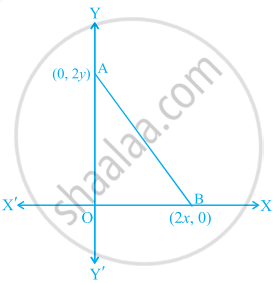Advertisements
Advertisements
प्रश्न
The distances of point P (x, y) from the points A (1, - 3) and B (- 2, 2) are in the ratio 2: 3.
Show that: 5x2 + 5y2 - 34x + 70y + 58 = 0.
उत्तर
It is given that PA: PB = 2: 3
`"PA"/"PB" = (2)/(3)`
`"PA"^2/"PB"^2 = (4)/(9)`
`((x - 1)^2 + (y + 3)^2)/((x + 2)^2 + (y - 2)^2) = (4)/(9)`
`(x^2 + 1 -2x + y^2 + 9 + 6y)/(x^2 + 4 + 4x + y^2 + 4 - 4y) = (4)/(9)`
9(x2 - 2x + y2 + 10 + 6y) = 4(x2 + 4x + y2 + 8 - 4y)
9x2 - 18x + 9y2 + 90 + 54y = 4x2 + 16x + 4y2 + 32 - 16y
5x2 + 5y2 - 34x + 70y + 58 = 0
Hence, proved.
APPEARS IN
संबंधित प्रश्न
Find the value of x, if the distance between the points (x, – 1) and (3, 2) is 5.
Find the distance between the following pairs of points:
(2, 3), (4, 1)
Find the value of a when the distance between the points (3, a) and (4, 1) is `sqrt10`
Two opposite vertices of a square are (-1, 2) and (3, 2). Find the coordinates of other two
vertices.
Find the distance of the following points from the origin:
(ii) B(-5,5)
Find the distances between the following point.
P(–6, –3), Q(–1, 9)
Find the value of y for which the distance between the points A (3, −1) and B (11, y) is 10 units.
Distance of point (-3, 4) from the origin is .....
(A) 7 (B) 1 (C) 5 (D) 4
If the point P(2, 1) lies on the line segment joining points A(4, 2) and B(8, 4), then ______.
A line segment of length 10 units has one end at A (-4 , 3). If the ordinate of te othyer end B is 9 , find the abscissa of this end.
Prove that the points (0 , 2) , (1 , 1) , (4 , 4) and (3 , 5) are the vertices of a rectangle.
A point A is at a distance of `sqrt(10)` unit from the point (4, 3). Find the co-ordinates of point A, if its ordinate is twice its abscissa.
Give the relation that must exist between x and y so that (x, y) is equidistant from (6, -1) and (2, 3).
By using the distance formula prove that each of the following sets of points are the vertices of a right angled triangle.
(i) (6, 2), (3, -1) and (- 2, 4)
(ii) (-2, 2), (8, -2) and (-4, -3).
The distance between point P(2, 2) and Q(5, x) is 5 cm, then the value of x ______
Find distance between point Q(3, – 7) and point R(3, 3)
Solution: Suppose Q(x1, y1) and point R(x2, y2)
x1 = 3, y1 = – 7 and x2 = 3, y2 = 3
Using distance formula,
d(Q, R) = `sqrt(square)`
∴ d(Q, R) = `sqrt(square - 100)`
∴ d(Q, R) = `sqrt(square)`
∴ d(Q, R) = `square`
The point which divides the lines segment joining the points (7, -6) and (3, 4) in ratio 1 : 2 internally lies in the ______.
The coordinates of the point which is equidistant from the three vertices of the ΔAOB as shown in the figure is ______.

The distance of the point P(–6, 8) from the origin is ______.
|
In a GPS, The lines that run east-west are known as lines of latitude, and the lines running north-south are known as lines of longitude. The latitude and the longitude of a place are its coordinates and the distance formula is used to find the distance between two places. The distance between two parallel lines is approximately 150 km. A family from Uttar Pradesh planned a round trip from Lucknow (L) to Puri (P) via Bhuj (B) and Nashik (N) as shown in the given figure below.
|
Based on the above information answer the following questions using the coordinate geometry.
- Find the distance between Lucknow (L) to Bhuj (B).
- If Kota (K), internally divide the line segment joining Lucknow (L) to Bhuj (B) into 3 : 2 then find the coordinate of Kota (K).
- Name the type of triangle formed by the places Lucknow (L), Nashik (N) and Puri (P)
[OR]
Find a place (point) on the longitude (y-axis) which is equidistant from the points Lucknow (L) and Puri (P).

